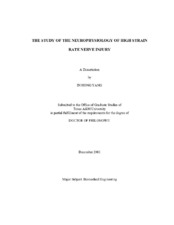| dc.description.abstract | The study of the mechanism of traumatic brain injury (TBI) processes at the cellular level is vital to obtain characterization of nerve cell damage after mechanical deformation. This understanding is needed to find feasible therapeutic targets for mechanically damaged neurons. To study the cellular level of TBI damage, development of a new in vitro cellular model of TBI might be done to simulate in vivo cellular TBI.
In this research, two studies were performed: (1) the design and construction of an in vitro cell stretching device to mechanically injure cells and (2) the characterization of the molecular and cellular level of the TBI mechanism. The cell stretching device design allows for the precise control of cell strain and duration of stretching cells such that TBI can be mimicked. Analysis of the cellular and molecular level mechanisms of TBI in the proposed in vitro model might help in the design of therapeutic strategies for the treatment of TBI. Our proposed mechanism of injury due to TBI is as follows: after the cell is stretched, a cellular signaling molecule is released to activate the cellular signaling pathway. The activated cell signal may activate kinases which phosphorylate proteins and initiate new protein synthesis. Newly phosphorylated and synthesized proteins may activate the apoptotic process.
Using a variety of pharmacological agents, one could block steps in the hypothesized mechanism and examine the effect of those agents on downstream cellular processes and cell apoptosis. For example, the inhibitions of calcium transport, protein synthesis, and caspases were performed to examine the initial activation of the signaling pathway and the role of both in the apoptosis process. Proteomics of TBI may help the understanding of the mechanism of TBI related protein expression. This work will contribute to the discovery of new therapeutic targets and better treatments for TBI. | en |


